Dec 29, 2015 | coins, Eagles, legislative, silver, US Mint
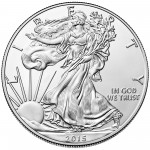 At the end of my last report on how the recent transportation bill will have an effect on coin collectors, I said that I would discuss how the new law will impact American Silver Eagle collectors. After taking a little time off for holiday festivities, we are going to look at the impact and unintended consequences of congress.
At the end of my last report on how the recent transportation bill will have an effect on coin collectors, I said that I would discuss how the new law will impact American Silver Eagle collectors. After taking a little time off for holiday festivities, we are going to look at the impact and unintended consequences of congress.
To review, earlier this month congress passed and the president signed the Fixing America’s Surface Transportation Act or the “FAST Act” (H.R. 22; now Public Law 114-94). It is a comprehensive transportation bill that is over 490 pages long with one third of those paged dedicated to items other than transportation. Buried deep in the document is Title LXXIII, “Bullion and Collectible Coin Production Efficiency and Cost Savings” section. For today’s post, we look at Section 73002:
Sec. 73002. American Eagle Silver Bullion 30th Anniversary
Proof and uncirculated versions of coins issued by the Secretary of the Treasury pursuant to subsection (e) of section 5112 of title 31, United States Code, during calendar year 2016 shall have a smooth edge incused with a designation that notes the 30th anniversary of the first issue of coins under such subsection.
If you are not familiar with “subsection (e) of section 5112 of title 31, United States Code” (31 U.S.C. § 5112(e)), it is the part of the law that authorizes the American Silver Eagle program. It says that these coins are to 40.6 millimeters in diameter containing 31.103 grams (one troy ounce) of .999 fine silver with a symbolic design of Liberty on the obverse and an eagle on the reverse.
Along with the prescribed elements the coin will have a reeded edge. It is this reeded edge requirement that may be causing a problem.
As written, Section 73002 does not say that the 2016 coin with a smooth edge with an inscription designating as the 30th anniversary of the first issue is for a special collectible. It is written as a blanket statement for all coins issued in 2016. Because of the word issued, the U.S. Mint is going to cancel the 2015 Limited Edition Silver Proof set.

2014 Limited Edition Silver Set (LS3) will be on sale until December 30, 2015 at noon.
However, that word “issued” causes a problem. If the coins are part of a packaging production, the coins may not have been struck in 2016 but the sets are being issued in 2016, then the 2015 could be violating the law. It is that ambiguity in a law passed by congress that will cause the 2015 Limited Edition Silver Proof set from being released.
Sausage making at its finest!
Images courtesy of the U.S. Mint
Dec 5, 2015 | coins, Eagles, legislative, silver, US Mint
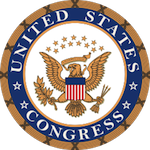 I know that there is little the U.S. Mint can do without congress’s permission, but sometimes sifting through what congress is doing can be tiresome. There is so much good that congress can do but the political in-fighting is so insidious that all one can do is shake their head in disgust. At least there is one interesting item to report:
I know that there is little the U.S. Mint can do without congress’s permission, but sometimes sifting through what congress is doing can be tiresome. There is so much good that congress can do but the political in-fighting is so insidious that all one can do is shake their head in disgust. At least there is one interesting item to report:
H.R. 22: Developing a Reliable and Innovative Vision for the Economy Act
Sponsor: Sen. Rodney Davis (R-IL)
• Introduced: January 6, 2015
• Passed House of Representatives on January 6, 2015
• Passed Senate with amendments on July 30, 2015
• Conference report presented to Senate on November 5, 2015
• Conference committee convened November 18, 2015
• Of significance to numismatics:
- SEC. 73002. AMERICAN EAGLE SILVER BULLION 30TH ANNIVERSARY: Proof and uncirculated versions of ASE coins during 2016 shall have a smooth edge incused with a designation that notes the 30th anniversary of the first issue of coins.
Track this bill at https://www.govtrack.us/congress/bills/114/hr22
In other words, congress is mandating a 30th Anniversary American Silver Eagle set. I wonder if it will match the 25th Anniversary set?
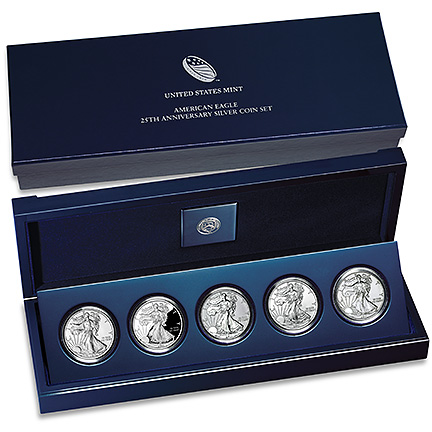
2011 American Silver Eagle 25th Anniversary Set
Image of American Eagle set courtesy of the U.S. Mint
Nov 24, 2015 | bullion, Eagles, gold, silver, US Mint
 As we wind down to the end of the year, the U.S. Mint has been announcing their end of the year production availability for 2015 American Eagle bullion coins. Starting with the announcement on November 14, 2015 that the quarter ounce $10 gold American Eagle bullion coin has sold out and no more will be produced. For 2015, the U.S. Mint has sold 39,500 ounces of quarter ounce American Eagle bullion coin representing 158,000 coins. This represents a 33-percent increase from 2014.
As we wind down to the end of the year, the U.S. Mint has been announcing their end of the year production availability for 2015 American Eagle bullion coins. Starting with the announcement on November 14, 2015 that the quarter ounce $10 gold American Eagle bullion coin has sold out and no more will be produced. For 2015, the U.S. Mint has sold 39,500 ounces of quarter ounce American Eagle bullion coin representing 158,000 coins. This represents a 33-percent increase from 2014.
A few days later on November 18, the U.S. Mint announced that the one-tenth ounce American Eagle gold bullion coin has been sold out. For the year, the U.S. Mint produced 980,000 of the one-tenth ounce gold American Eagle proof coins representing 98,000 ounces of gold. This year’s production is a bit more than 73-percent increase over the 565,000 coins struck in 2014.
UPDATE: In a 4:35 PM note (24-Nov-15), the U.S. Mint has announced that the one-ounce gold American Eagle bullion coin has sold out! Orders for 2016 bullion coins will begin on January 11, 2016.
The day after announcing that they will be restricting the production of the American Silver Eagle bullion coins to 1 million coins per week, the U.S. Mint announced that they will continue to produce the coins through the week of December 7, 2015. They anticipate that this will cover their full weekly allocation through Monday, December 14, 2015.
With the price of silver dropping, the U.S. Mint has produced 42,929,500 American Silver Eagle bullion coins to this point. Considering the allocation of 1 million coins per week with four weeks left of sales, the final total of silver coins should be between 46-47 million coins. This would be an increase over last year’s record of 44,006,000.
American Silver Eagle bullion coin image courtesy of the U.S. Mint.
Dec 10, 2014 | bullion, coins, Eagles, halves, silver, US Mint
A couple of quick news items that came out of the U.S. Mint on Tuesday.
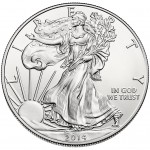 The U.S. Mint reported that as of December 8, 2014, they had sold a record 42,864,000 one troy ounce American Silver Eagle Bullion coins for all of 2014. This beats the previous record of 42,675,000 coins sold in 2013. Sales of the 2014 bullion coins to authorized dealers will end during the week of December 15.
The U.S. Mint reported that as of December 8, 2014, they had sold a record 42,864,000 one troy ounce American Silver Eagle Bullion coins for all of 2014. This beats the previous record of 42,675,000 coins sold in 2013. Sales of the 2014 bullion coins to authorized dealers will end during the week of December 15.
Taking a sample of five different bullion dealers, the average price is around $20 for one American Silver Eagle Bullion coin. If each coin is worth about $20 each, that means the U.S. Mint sold $857.28 million in silver bullion for 2014. Remember, this is for the bullion coin. This does not count the collectible versions such as the proof or the West Point struck uncirculated coin.
 The other announcement was that the U.S. Mint will sell a new product, Coin Discovery Set — An Introduction to Coin Collecting. The set costing $24.95 will include three 2014 Kennedy Half-Dollars in three different finishes—proof, uncirculated and circulating. It will also include two coin tubes for quarters, a magnifying glass, cotton gloves, and a booklet that explains the coin production process. The box will the the size to store U.S. Mint proof sets.
The other announcement was that the U.S. Mint will sell a new product, Coin Discovery Set — An Introduction to Coin Collecting. The set costing $24.95 will include three 2014 Kennedy Half-Dollars in three different finishes—proof, uncirculated and circulating. It will also include two coin tubes for quarters, a magnifying glass, cotton gloves, and a booklet that explains the coin production process. The box will the the size to store U.S. Mint proof sets.
Sales will open at noon Eastern Standard Time (1600 UTC) on Tuesday December 16, 2014. While there will be no household ordering limit, the U.S. Mint has set a product limit to 45,000 sets.
Images courtesy of the U.S. Mint.
Jul 22, 2014 | CCAC, coins, Eagles, gold, medals, silver, US Mint

Proposed reverse for the 2015 Ultra High Relief gold coin
Along with the gold coin will be a companion silver coin struck on the one-ounce planchet that is used for the American Silver Eagle. Although it was not specifically addressed, it is assumed that silver coin will be of the same or similar relief of the gold coin.
This afternoon I was able to break away from my daily activities to attend the CCAC meeting via conference call. This is the first time I attended one of their meetings and came away a little surprised and a little appalled.
What surprised me with the meeting is how in lock-step the committee is on everything. There appears to be no disagreement or questioning of what the U.S. Mint had proposed. Granted the committee members may have history with the issues beyond this meeting, but I was surprised that alternatives were not recommended or discussed.
The committee was excited because the proposal was somewhat in alignment with a motion they passed last April to create a Liberty Medal series. According to Gary Marks, chairman of the CCAC, the Liberty Medal Series would be an arts medal produced by the U.S. Mint to foster new design and innovation. It is to encourage the artists to have artistic impression beyond what they are allowed to do as part of the coin programs.
I do not know if it was previously discussed but according to the authorizing law for the American Silver Eagle bullion program (31 U.S.C. § 5112(e)(3)) the coins must have a design “symbolic of Liberty on the obverse side” and “of an eagle on the reverse side.” The law does not say that the obverse must be Adolph Weinman’s Walking Liberty design and it does not say that the reverse must be a heraldic eagle. Why has the committee not considered using the existing American Silver Eagle program to create a Liberty design program?
In discussing the overall medallic arts program, the CCAC decided to create a study group to come up with a plan to recommend to the U.S. Mint. Aside from the “American Liberty Silver Medal Program,” as described by Marks, he also proposed Freestyle Medal of an American theme. This would be one medal per year that would be artistic representations.
CCAC Member Heidi Wastweet said that the arts medal will allow for experimenting; allow the artist and designers to “expanding our wings” for future projects. As a result, it will let future stakeholders know what is possible so that it would inspire better designs.
While a medals program is a good idea, what seems to be missing is the subject matter. If the Liberty design can be leverage through the American Eagle bullion program, why not have medals used to honor history? Why is it when nations around the world issued commemorative coins honoring D-Day, the United States, whose mint is overly regulated by intransigent politicians, did not issue any commemorative item on the 70th anniversary of an event that changed world history?
Expanding the medals program in this manner would be the perfect way to honor history when congress has failed to remember they represent a country rather their owners… I mean donors!
Where I was appalled was what I saw as over-the-top cult-like patriotic gushing by some of the members over the proceedings. I thought the CCAC was supposed to be an oversight organization; at least that is how it appears to be described in the authorizing law (31 U.S. Code § 5135). There should not be a problem with supporting the work of the U.S. Mint and support the artists whom everyone agrees should be treated better. However, there were some comments that sounded more like members were wrapping themselves in the flag rather than working on an oversight committee.
As part of his closing remarks, Chairman Marks said, “I believe that this is the single most impactful idea that the Mint can pursue at this point in time in the United States.” Unfortunately, I wish this was the case. It appears to be another missed opportunity by the CCAC similar to previous missed opportunities by this committee.
I will have more commentary in the coming days.
Background from the U.S. Mint
Potential Products
2015 24-karat Gold Ultra High Relief Coin
2015 Silver Medal
Background
- As a result of the success and popularity of the 2009 Ultra High Relief Double Eagle Gold Coin, the United States Mint (Mint) is considering producing a 2015 24-karat Gold Ultra High Relief (UHR) Coin.
- The CCAC recommended a new eagle design for the reverse of the American Eagle Silver One Ounce Coin, a change the Mint is not pursuing, opting instead to consider showcasing the beauty and intricacies of the recommended design on a 2015 24k Gold UHR Coin.
- To compliment such a reverse, the Mint would consider featuring a new, modern rendition of Liberty on the obverse of the 2015 24k Gold UHR Coin.
- If developed, a 2015 24k Gold UHR Coin would be comparable to the 2009 Ultra High Relief Double Eagle Gold Coin, in that it would also be one troy ounce. The denomination would also have to be determined.
- To make such a design accessible to various ranges of collectors, the Mint is considering the possibility of producing a medal, struck in silver, bearing the same design as a 2015 24k Gold UHR Coin. Striking these medals in silver would provide an additional opportunity to showcase the intricacy of the design features and the beauty of the artwork.
- If this concept is pursued, the United States Mint would seek Secretary of the Treasury approval to strike this gold coin under authority of 31 U.S.C. § 5112(i)(4)(C).
- If this concept is pursued, the United States Mint would seek Secretary of the Treasury approval to strike this silver medal under authority of 31 U.S.C. § 5111 (a)(2).
Design History
- In 2009, the United States Mint fulfilled the original vision of Augustus Saint-Gaudens with the release of the 2009 Ultra High Relief Double Eagle Gold Coin; closing one chapter of American coin design and beginning a new one.
- If produced, 2015 24k Gold UHR Coins could be viewed as a follow up to the 2009 Double Eagle UHR, contrasting classic American coin design with modern American coin design.
Image courtesy of the U.S. Mint.
Jan 8, 2014 | coins, commentary, Eagles, news, other
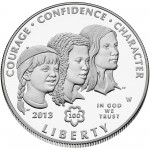
2013 Girl Scouts of the USA Centennial commemorative coin
Following the close of the year, the U.S. Mint told Coin World that the sales of the 2013-W Girl Scouts of the USA Centennial Commemorative coins was so low that it did not cover the costs of the program as required by law. U.S. Mint records show that 86,354 proof and 37,463 uncirculated coins were sold for a total of 123,817 coins. That is a little more than 35-percent of the 350,000 authorized by the law.
Sales of the 2013-W Girl Scouts of the USA Centennial Commemorative coins was to have ended on December 17, 2013 but the U.S. Mint extended the sale through December 31, 2013. By law, a commemorative coin can only be sold in the year it was struck.
The U.S. Mint cannot be faulted for this lack of interest. Information about the coin had been a fixture of the front page of the U.S. Mint’s website. Their information included a video introduction by United States Treasurer Rosie Rios and provided information in its various outreach programs. The U.S. Mint is limited on the type of advertising it is allowed to use.
Usually, the burden of advertising falls to the organization that would most benefit from the sale of the commemorative coin. Since I do not have a connection with Girl Scouts of the USA, I cannot report on their promotional experience.
This news is both sad and troubling. Although there are collectors who will buy the coin to be part of their commemorative collection, the real success or failure of a commemorative coin is based on its subject. For whatever reasons, the Girl Scouts was not a popular subject.
When a commemorative is made for an organization, purchasers want some affinity for the organization. Unless you are a collector, you are not going to buy a coin honoring that organization, especially when the price is over $50 during a recovering economy. I wonder if a clad half-dollar may have been a better idea?
While having a program to honor the centennial of the Girl Scouts of the U.S.A. was a laudable idea, maybe it was not a good one. It was a coin with a limited appeal and those in the target audience did not respond.
It is also troubling that the Girl Scouts were not able to generate more sales on its own. In coming up over 31,000 coins short of being able to receive the payout, it is time to question the diversity of the hobby—again.
Numismatics is dominated by middle-aged to older white males. While there is an outreach to young numismatists, those programs appear to succeed in recruiting mostly white boys and keeping them interested until they become 18 years old.
Consequently, there appears to be no concentration on providing opportunities to young girls and minorities. While the Boy Scouts provide one outlet, local experience shows that those troops are dominated by young white males. Surely there are girls and minorities interested in numismatics. If not, why not?
If anyone missed the point, the executive directors of the American Numismatic Association and Industry Council for Tangible Assets (ICTA) are women. I do not believe either have their jobs because they are women. They are qualified people leading an industry that happens to male dominated.
There has to be a way to appeal to the demographics that are not being represented in the hobby. Aside from women and minorities, the hobby has to figure out how to engage those older than young numismatist (YN) but younger than middle-age. There has to be a way to keep them interested if they started as a YN or grab their interest before middle age. In 2011 I addressed these issues calling potential members the “Lost Demographic.” There have been little changes since.
What will it take to expand the hobby to all sectors of society? Please feel free to let me know in the comments section below. We can all work together for the betterment of the hobby!
Dec 27, 2013 | coins, Eagles, gold, silver, US Mint
The collecting public has been enamored with the American Silver Eagle reverse proof. By making the fields look matte and the effigy of Adolph A. Weinman’s Walking Liberty design in a stunning mirror finish, the coin has become a favorite with collectors. Prior to this year, the U.S. Mint produced the American Silver Eagle for the 2006 20th Anniversary Silver Eagle set, 2011 25th Anniversary Silver Eagle set, and the 2012 75th Anniversary of the San Francisco Mint set.
This year, the reverse proof was included in the “2013 American Eagle West Point Two-Coin Set.” The coins were struck as the U.S. Mint branch facility in West Point, New York. The coins feature the “W” mintmark.
Included with the reverse proof coins was a coin that the U.S. Mint called “enhanced uncirculated.” While it looks like a proof coin, the enhanced portion are the selective frosting of elements. Introduced earlier this year, the new laser frosting technique allows the U.S. Mint to selectively apply the frosting texture to areas of the dies in a matter that leaves fine details of the coins. For the enhanced American Silver Eagles, the selective frosting leaves the folds of Miss Liberty’s skirt mirrored and is used to show off the flag she is holding. Weinman’s Walking Liberty image is one of the best designs every to appear on a U.S. coin. Enhancing it in this manner just makes it pop in a way Weinman could never imagine.
-

-
2013-W American Silver Eagle reverse proof
-

-
2013 American Eagle West Point Two-Coin Silver Set with reverse proof and enhanced uncirculated coins.
-
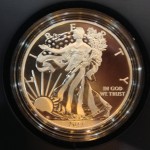
-
2013-W American Silver Eagle enhanced uncirculated coin
In a recent conversation with Acting Mint Director Richard Peterson, he said that the U.S. Mint’s most successful coin launch in recent history was the American Buffalo reverse proof coin. The coin was first offered for sale at the World’s Fair of Money this past August, the U.S. Mint did not have enough inventory in order to meet the demand.
-

-
2013-W American Buffalo gold reverse proof obverse
-

-
Reverse of the 2013-W American Buffalo gold reverse proof
-
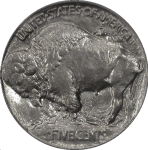
-
1913 Buffalo Nickel Type 1 Reverse
The 24 karat gold coin that was first issued in 2006 featuring the 1913 Type 1 Buffalo Nickel, was issued to celebrate the 100th anniversary of the design by James Earle Fraser. Fraser, who had a reputation as being a finicky artist, would likely be happy to see his Type 1 Buffalo nickel design as a gold reverse proof coin. Black Diamond never looked so good!
Although it has not been announced, Peterson suggested that the Kennedy half dollar may see an enhancement. Since 2014 will be the 50th anniversary of the Kennedy Half Dollar, expect the U.S. Mint to do something for this anniversary. It would not be a surprise to see a set with reverse proof and enhanced uncirculated coins.
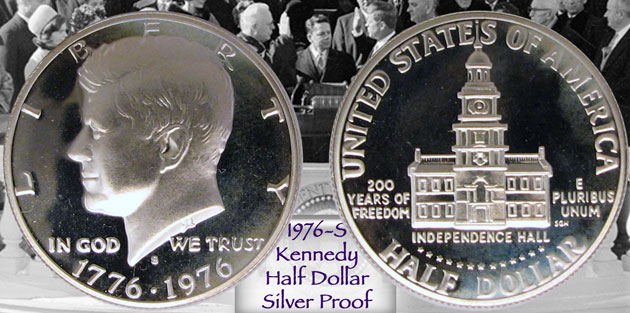
Using the enhanced uncirculated treatment, if a 2014-S coin paid tribute to the Bicentennial reverse, can you imagine how good that would look?
Nov 25, 2013 | bullion, coins, commemorative, Eagles, poll, US Mint
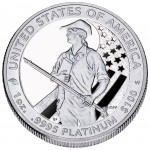
2012 American Eagle Platinum Proof reverse “To Provide for the Common Defence”
Let’s pretend that the Citizens Coinage Advisory Committee could bypass congress (very wishful thinking!), Citizens Coinage Advisory Committee, and the U.S. Commission of Fine Arts to build a portfolio of non-circulating legal tender commemoratives to increase collector sales. Today’s poll, which will run for two weeks, asks what the U.S. Mint should do with its pretend freedom.

Loading ...
For the record, I am in favor of allowing the U.S. Mint to increase the offerings under the American Eagle program. The U.S. Mint has done some of that to this point with the enhanced reverse uncirculated coins and special sets. There should be more special offerings or different offerings. The U.S. Mint could change the reverse designs to honor different themes like they have been doing on the reverse of the platinum American Eagle coins.
I would also like to see more of the enhanced uncirculated American Silver Eagle coins. The way it enhanced Adolph Weinman’s Walking Liberty design makes it a great looking collectible.
Oct 30, 2013 | CCAC, coin design, coins, commentary, Eagles, platinum
The buzz around the numismatics industry is the article that appeared on the front page of Coin World saying that the Citizens Coinage Advisory Committee rejected the U.S. Mint proposal to use classic coin designs as the basis for a new series of American Eagle Platinum Proof coins.
According to the article, CCAC Chairman Gary Marks commented, “My message is, ‘Let’s do something modern, something new.’”

2012 American Eagle Platinum Proof reverse — “To Provide for the Common Defence”
Unlike other coin programs, the law governing the platinum bullion coins (31 U.S.C. §5112(k)) allows “The Secretary [to] mint and issue platinum bullion coins and proof platinum coins in accordance with such specifications, designs, varieties, quantities, denominations, and inscriptions as the Secretary, in the Secretary’s discretion, may prescribe from time to time.”
Now, The Secretary’s proxy, the management at the U.S. Mint, is proposing a series based on classical coins designs. Using charts showing declining coin sales, they claim that a study shows that “classic Eagle” and “classic coin” designs are popular amongst their customer.
The U.S. Mint may be reading too much into their studies.
First, any sales studies over the last four years have to be taken with a heavy dash of salt. As much as the economy affects their circulating coin programs it also affects the collector coin programs. Since coin collecting is not a necessity, expecting sales to do anything but decline during an economic downturn is naive.
The other problem with coin sales are the coins programs themselves. Rather than give the quarters programs a rest and come up with something different, congress, who decides what the U.S. Mint can do, passed the America’s Beautiful National Parks Quarter Dollar Coin Act of 2008 (Public Law 110-456) to overload our senses with yet another 10-year program. It was justified by noting the seigniorage of the 50 States Quarters program.
This leads to the crux of the problem: the tail wagging this dog are marketeers and bureaucrats rather than collectors and those concerned with how American coinage represents this country.

1928 Peace Dollar is a classic and under-appreciated design
A lot of people love the classic designs but on the classic coins. There comes a time to move forward and come up with something different and fresh. Although I have not agreed with some of the CCAC’s decisions, I agree with this decision.
When asked if there should be a theme to the design, CCAC member and medal sculptor Wendy Wastweet said, “No. The artists would be delighted to be free.”
Why not let the U.S. Mint artists have free reign to come up with new designs? They have proven that when allowed to use their talents they can create some of the best designs in the world.
The CCAC has been consistent in tell the U.S. Mint to get out of the way of the artists. In fact, the CCAC Blueprint Report released in February 2011 recommended better working conditions for the U.S. Mint’s artists and engravers while giving them a freer hand in using their talents for new coin designs.
In more than two years, the U.S. Mint has not changed allowing their marketing bureaucracy misread statistics in an attempt to fix a problem they continually demonstrate they have no understanding or insight. The CCAC is right to tell the U.S. Mint to come up with something better. In the process, if the marketing department would stand aside and let the artists be creative, I am reasonably certain these talented individuals will create something far more interesting than any marketeer, bureaucrat, or any member of congress.
American Eagle Platinum proof reverse courtesy of the U.S. Mint.
Jun 7, 2013 | bullion, coins, Eagles, gold, news, silver, US Mint, video
 This year, the U.S. Mint Facility at West Point, New York turn 75 years old. When opened in 1937, it was to be the nation’s silver bullion depository giving it the nickname “The Fort Knox of Silver.” In 1988, West Point was granted mint status.
This year, the U.S. Mint Facility at West Point, New York turn 75 years old. When opened in 1937, it was to be the nation’s silver bullion depository giving it the nickname “The Fort Knox of Silver.” In 1988, West Point was granted mint status.
The “W” mintmark on U.S. coins is highly prized since it is the only mint not to strike circulating coins with its own mintmark. While the West Point Mint did strike cents from 1973 through 1986, the coins produced were not struck with a mintmark.
Today, the West Point Mint only strikes precious metal coins. From commemoratives through bullion American Eagle coins, West Point produces more precious metal coins than any other Mint in the world, including the San Francisco Mint.
Located just outside the United States Military Academy, the West Point Mint does not allow visitors or tours for security reasons. However, exceptions are made. With the facility celebrating its 75th anniversary, the U.S. Mint has been allowing journalists to visit and take pictures of their operations.
Thus far, the best set of images were published in the Daily News. In the article, “West Point Mint, with $80 billion in precious metals, celebrates 75th anniversary,” the reporters visit the West Point Mint and bring back some very interesting picture. You can read the story on the Daily News’s website or if you just want to see the pictures, you can see this board I created on Pinterest.
The Daily News also created a two-minute video looking inside the facility. The video follows (if it begins with a commercial, it is being sent by the Daily News—the cost of embedding their video):
If you are having problems seeing the video, go here.
All images and the video courtesy of the Daily News.
 At the end of my last report on how the recent transportation bill will have an effect on coin collectors, I said that I would discuss how the new law will impact American Silver Eagle collectors. After taking a little time off for holiday festivities, we are going to look at the impact and unintended consequences of congress.
At the end of my last report on how the recent transportation bill will have an effect on coin collectors, I said that I would discuss how the new law will impact American Silver Eagle collectors. After taking a little time off for holiday festivities, we are going to look at the impact and unintended consequences of congress.
 I know that there is little the
I know that there is little the 














